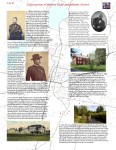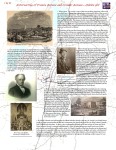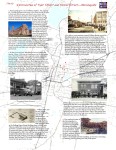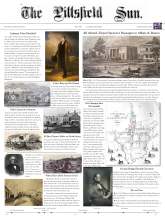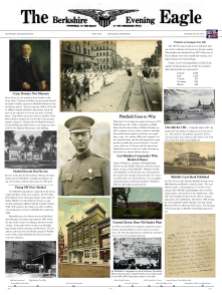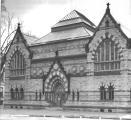Have a Great Week! Love!
Posted by John Dickson in Personal memory on December 6, 2023
People my age at some point come to a realization that it would be a good idea to cull through the boxes of stuff accumulated over the years, at least to spare our children from such an effort after we have, ahem, moved on, so to say. In my case, it really was to reduce their workload, not to hide anything, although once I got going, there was plenty I did want to hide.
I started with the boxes of letters I had carted around the world. I was actually saving the stamps, but, in my haste, I just stuffed the letters back in the envelopes and put them in boxes. No particular order. I convinced myself that I was a stamp collector and would turn to that vocation in a big way once I retired. You can imagine these boxes, randomly stuffed, full to the brim. There were four or five of them. As we moved around the world, they moved with us and the letters piled up, with stamps from across the U.S., Africa, Latin America and, of course, the small town where my parents were living, Pomfret Center Connecticut.
Many of those letters did end up in the fireplace, but not the ones from my father who had recently passed away. He had written a letter to his children, each week, for almost 30 years. The same letter, typed, with a handwritten note in the top corner usually. At first, he would insert in his typewriter five blank pages, separated by carbon papers, making the letters of uneven quality. We each wished our copy would be the top one from his typewriter. He then advanced to photocopying, running to the local stationery store each Monday before he headed to the post office to send them off. Clockwork: Sunday evening writing, Monday morning copying and mailing.
And I saved them, as did my brothers and sister until she passed away. It may have been her letters which my father found clearing out her apartment which spurred him to begin saving a copy as well, for the record.
So, one early morning before work, I cut through the tape of the first box, blowing the dust off the top, and took up the top letter, with scissors in hand to cut off the stamps from the corners of the envelopes. After looking through a few of the letters from my father, I hesitated. There were gems among these pages, little sparkles of inspiration and feel-good stories that certainly would appeal to our immediate family, but perhaps to others as well.
So, using the laborious technology at the time, I decided to scan each letter, and select the items that capture his personality, and the place and time he lived in.
Beyond the refreshings of my memories of college, young adulthood, marriages and children, jobs and travels and visits home, it was also probably part of my grieving process, part therapy to talk with and listen to my father, realizing that while there was much I would have wanted to ask him, I was able to uncover nuggets of his life, his values, his advice that I had simply forgotten, buried in these letters.
So, it turned out to be a labor of love. For many years, I figured it took one hour to scan five letters, read through them and select any potentially worthwhile excerpt, and cut and paste them into other documents organized thematically, like grandchildren, travels, pets, health, culture, etc. Do the math, five letters an hour, well over a thousand letters. I started in 2005 and finished during the pandemic. Totally worth it.
But all my effort was nothing compared to the discipline and perseverance he showed, drafting a letter each week for 29 years. That’s devotion and affection. All bound up in one volume, Have a Great Week! Love! That title is how he ended each letter.
Hopefully, my next clean-out project won’t lead me down as long a path as this one did.
History Shock – A Personal Journey
Posted by John Dickson in International, Personal memory on January 31, 2022
On a Saturday morning, four days after the Haitian earthquake in 2010, I was sitting in my office finalizing travel schedules for Foreign Service Officers who had volunteered for temporary duty on the devastated island. We needed to ramp up press support for the hundreds of journalists in Haiti and the thousands more around the world calling the U.S. Embassy for updates on the relief effort. The phone rang, and it was a journalist from Nicaragua who wanted an official reaction to President Daniel Ortega’s claim that the U.S. was planning a military invasion to take over Haiti. Chuckling to myself, I noted the U.S. military was really the only organization that could handle, in a timely way, the international relief effort for one of the worst disasters in human history. I hung up, thinking I had put that falsehood to rest.
On a Saturday morning, four days after the Haitian earthquake in 2010, I was sitting in my office finalizing travel schedules for Foreign Service Officers who had volunteered for temporary duty on the devastated island. We needed to ramp up press support for the hundreds of journalists in Haiti and the thousands more around the world calling the U.S. Embassy for updates on the relief effort. The phone rang, and it was a journalist from Nicaragua who wanted an official reaction to President Daniel Ortega’s claim that the U.S. was planning a military invasion to take over Haiti. Chuckling to myself, I noted the U.S. military was really the only organization that could handle, in a timely way, the international relief effort for one of the worst disasters in human history. I hung up, thinking I had put that falsehood to rest.
Within days, Ortega’s comments had spread through a hemisphere that saw plausibility in his claim, based on an awareness that the U.S. had occupied that country for almost 20 years from 1915-1934. I, on the other hand, did not know of that history, and I wondered later how many of the thousands of Americans representing multiple U.S. government agencies on the ground in Haiti were similarly unaware.
It took a concerted effort involving press statements and interviews within the country and around the world to push back against the falsehood. It was a distraction from what should have been a positive narrative about the full weight of the U.S. government and its people to come to the aid of the stricken nation. The story only went away with the departure of the military after they had wound down their mission of immediate relief and restoration of damaged infrastructure.
The incident that quiet Saturday morning underscored, though, a growing uneasiness I had experienced in my overseas assignments related to understanding history. I was either unaware of the history of the country and its relations with the United States, or I had a very different understanding than the people with whom I was interacting. I came to call this sensation, “history shock,” a play on the broader notion of culture shock, with one exception. I was actually prepared for the shock of experiencing cultural differences; I never anticipated the differences related to history.
As I delved into histories of U.S. relations in these countries, one recurring question kept arising – how come I didn’t know this before? Not only was I unaware of the occupation but that atrocities had occurred, but that they had been fully investigated by U.S. Congressional committees. It took subsequent research to learn that we had resorted to the French system of forced labor (the hated corvée) in a country that was unique in human history for its successful slave revolt leading to independence. Up to 11,000 people may have died because of bloody guerrilla fighting over the 19 years.
Other histories likewise shocked me, a history major in college and teacher before joining the Foreign Service. Personal experiences were easy to amass. For example, I don’t recall in any course I took or taught any reference to the burning of the city of York (now Toronto) in the War of 1812, before the British burned Washington DC. I hadn’t heard of Teddy Roosevelt’s blatant grab of Panama, manufacturing a revolt against Colombian rule to send in American forces and restore order so he could build a canal across the isthmus when the Colombians had denied him. It was a maneuver repeated in Guatemala, in Nicaragua, in Iran, and attempted at the Bay of Pigs. I should have known how prominently the Platt Amendment played in Cuba, but my knowledge of the Spanish-American War in 1898 was limited to Roosevelt and the Rough Riders. Enacted after the war, the Platt Amendment gave the U.S. the right to intervene in Cuba and exercise control over its foreign and military policies. It stood until 1934. “Platt” became shorthand across the continent for U.S. interventionism, a term that Fidel Castro used repeatedly in his speeches as he took power in Cuba.
Further, I didn’t know that Malcolm X had been to Nigeria in 1964, and his statements about American diplomats trying to sugar-coat race relations in the U.S. as progress still resonated with the Nigerians we interacted with 20 years later. Nor was I aware that race relations in the U.S. was recurring fodder in Soviet anti-American propaganda during the 1950s and was one argument for eventual passage of the Civil Rights Act.
All these incidents led me to explore this connection between history and foreign relations, between history and memory. I enrolled in a graduate history program at UMass Amherst, and my book is the result of my studies there, a coming to terms with my personal experiences.
I am not comforted especially that this “history shock” experience is not confined to me personally, as I hear from former and current colleagues, as well as people outside the profession, of their own encounters. Furthermore, it seems that every day new examples of history shock emerge. In the current impasse with Russia over Ukraine, Vladimir Putin is drawing on a competing history of the end of the cold War to justify his threatened invasion, citing an out-of-context remark by Secretary of State James Baker about NATO advancing “not one inch” eastward after the reunification of Germany.
A number of people outside the profession have commented that they were amazed and even appalled that the U.S. would send out to Embassies representatives so ill-versed in history. Several historians who reviewed the book noted that this reflects the lack of historical awareness more broadly, across our society, reinforcing what the author Gore Vidal called the United States of Amnesia. And, my advisor at UMass asked that I insert in the text of my book the obvious reality that it is quite impossible for any single officer to arrive in the diplomatic corps knowing all these histories.
Beyond admitting my own ignorance, I speculate that a number of other factors are also at play. Ours is a culture that looks forward, not back. We are a society that has built a narrative that we are exceptional, an indispensable nation, and we choose to forget those accounts that don’t back up that view. In addition, we have opted for a Foreign Service that moves people around every couple of years, so that our diplomats don’t develop “clientitis.” In the process, though, they also don’t develop a truly in-depth understanding. We have a Foreign Service that prioritizes generalists, not specialists. Formal training for officers is insufficient. My own experience is probably not the norm, but I had eight months of training. In a career of 26 years. That leaves the process of learning about the host nation at the sole discretion and initiative of the individual officers. Finally, I would add to the list the decline in the study of history and general historical awareness in the broader culture.
The question remains, though, how we can use history better in the conduct or our diplomacy, to advocate for U.S. interests abroad. Here, too, examples readily come to mind. The return of looted archaeological items to Peru helped our Ambassador weather the criticism he faced in his outspoken promotion of human rights and democracy there. Harry Truman helped his case to persuade Mexico to sign the Rio Treaty launching the Organization of American States by the simple act of laying a wreath at the Monument to the Niños Héroes commemorating the soldiers who threw themselves off the walls of Chapultepec Castle rather than be taken prisoner by invading U.S. forces.
By acknowledging the history when the U.S. fell short of its ideals, our diplomats can reduce tensions. By acknowledging the history that is important to our counterparts, U.S. diplomats can build bridges. and, by being aware of the gap in interpretations of the same events, the U.S. can work to find the common ground needed to advance both countries’ objectives.
Originally published in The Diplomatic Diary, January 23 2022
History Lessons – The Streets of Pittsfield
Posted by John Dickson in Berkshires, History in our surroundings, Public History on February 27, 2021
Several times a week, in all weather, I drive to Pittsfield State Forest to hike the varied paths there. On my way, I pass over Pecks Road, then Dan Casey Memorial Drive before turning on to Churchill Road. Almost every time, I wonder who Dan Casey was or who was this Churchill? Could it be the Prime Minister of England?
I knew about Peck, since Jabez Peck ran two textile mills on this road, for over 50 years. It turns out Churchill is named after John Churchill, a captain in the Revolutionary War, who bought land for a farm on what is now state forest. Dan Casey was a city councilor who lived up on Hancock Road and loved fishing. He advocated for a causeway to be built over Onota Lake, and when he passed away, the council named the road for him.
These were just a few of the gleanings of Pittsfield history that emerged from research for the virtual exhibit, “What’s in a Name?” The Berkshire County Historical Society sponsored this exhibit for the annual 10×10 Upstreet Arts Festival put on by the city each February. You can find the 10 panels of the exhibit here: What’s in a Name? The Streets of Pittsfield. (Special thanks need to go out to Chris Laney at Berkshire Community College and the Local History Department at the Berkshire Athenaeum for their assistance.)
Many streets have nothing to do with historical figures, named after the children of the construction developers, or trees, flowers and seasons, and even directions and numbers. But, others do tell a story of Pittsfield. As might be expected, there’s a heavy emphasis on business and industry, given the city’s long history of manufacturing. Street names such as Pomeroy and Kellogg and Stanley and Dan Fox span the centuries of Pittsfield’s business evolution.
Likewise, it would be no surprise that the town’s founders (Wendell, Crofut, or Merrill) would grace the street signs or that the military heroes, such as Easton, Brown or Williams should be recognized. For others, like Colt, Melville and Allen, members of the same family are honored.
What comes through, though, is another truth about the history of the city. No women or people of color are recognized.
What does that absence tell us? For one thing, for many years, only white men could own property, could vote and run for office, by law. Even when the laws changed, women and people of color did not enter the ranks of business ownership or politics, by discrimination.
Yet, there are streets named after directors of schools (Tyler and Dewey), but not Clara Wells or Mildred Hall who opened girls’ schools in the 1800s. Or, William Plunkett, a director of the Berkshire Athenaeum, gets a street but not Amy Miller, who was president of the same library and founder of Hancock Shaker Village. Samuel Harrison clearly served the city and the nation, as the first minister of the Second Congregational Church, and, as chaplain for the all-Black Massachusetts 54th regiment in the Civil War, he fought for and won equal pay for Black soldiers.
It’s inconvenient to change street names, especially for people whose homes are on that street and have to change postal addresses. But, it’s been done in the past, as there were numbered streets on the west side of North Street where Robbins (shoe factory), Dewey (education), and Center Street are now located. One developer who built houses on Kremlin Street was even able to get that street named to Lillian when he thought no one would want to live on a street linked to communism.
Given the moment of national reckoning we are in, moving to make corrections of the local record is a small, but important step and worth the inconvenience.
This post first appeared in The Berkshire Eagle, February 27, 2020.
How did we get here?
Posted by John Dickson in Public Affairs, Public History on July 4, 2020
Last weekend, Princeton University announced they were dropping the name Woodrow Wilson from its school of international affairs and public policy and from one of its colleges.
The President of the University, Christopher L. Eisgruber, noted in his announcement that Wilson displayed a racism that “was significant and consequential even by the standards of his own time.”
My initial reaction was skeptical. Removal of the symbols of the Confederacy – statues and flag – was long overdue. These commemorated people and a breakaway republic that fought against the United States in order to preserve slavery. Monuments and building names of other prominent Americans without this clear-cut past, like Wilson, have come under closer scrutiny as well. New York Times columnist Brett Stephens tried to distinguish between historical figures who should not be celebrated from those who had flaws, like all human beings. He drew his line based on whether or not people worked to “establish a more perfect union,” as outlined in the 1776 Declaration of Independence.
The case of Woodrow Wilson seemed less straightforward: professor of political economy, President of Princeton, Governor of New Jersey and two-term President with a progressive and internationalist legacy.
History, though, is written in the present, for the present. It answers the question – how did we get here? The Wilson of the present is not the man who crafted fourteen principles on which to shape a treaty to end the first world war, not the man whose name is attached to an American foreign policy tradition of globalism and moralism.
Eisgruber calls the current moment in American race relations, and, more broadly, in American society, “a searing present.” So, we should ask how did this moment become searing? A resurgence of racism, apologized by and condoned from the top. On the same day that Princeton announced its decision, the President of the United States posted a video on his Twitter feed of one Florida supporter shouting “Where’s your white hood?” and another calling back “white power.” It is, therefore, not surprising perhaps that a few days later Trump criticized the Princeton decision to remove the Wilson name.
So, what was Wilson’s legacy on the road to the searing present? Before he was President, Wilson wrote in his five-volume History of the American People that ”white men of the South were aroused by the mere instinct of self-preservation […] until at last there had sprung into existence a great Ku Klux Klan.”
It was his decisions while President, though, that helped steer the country to where are now. Wilson could have left alone a racially integrated civil service, but he did not. The civil service had officially been integrated since immediately after the Civil War, but Wilson oversaw the segregation of federal departments shortly after getting sworn in, emphasizing “I would say that I do approve of the segregation that is being attempted in several of the departments.” He cut short a meeting with Black leaders who came to protest these policies. It took 35 years before Harry Truman would issue an executive order prohibiting racial discrimination in the federal service.
Less significant except for its high symbolism, Wilson decided to invite D.W. Griffith to the White House to screen his pro-Ku Klux Klan film, Birth of a Nation, the first film of any kind to be shown in the Presidential mansion. The film used Wilson’s quote on the “great Ku Klux Klan” as one of its intertitles. Protests and riots ensued, but Wilson claimed innocence in awareness of the film’s intent.
History is not supposed to be counterfactual, but it is not hard to imagine a different course of Jim Crow history in the 20th century had Wilson pursued progressive reforms on civil rights as vigorously as he did with policies as varied as child labor, woman suffrage (albeit belatedly,) national banking and income tax.
While history helps us answer how we got here, it also should help guide us towards where we want to be, and surely that is far away from this searing present. Princeton’s decision is almost an easy one, with tougher choices ahead on policies to address the racism that Black citizens confront on a daily basis.
This first appeared in the Berkshire Eagle, July 3, 2020.
Intersections – Ten Pittsfield Neighborhoods
Posted by John Dickson in Berkshires, History in our surroundings, Immigration, Public History on February 26, 2019
One of the only computer games I ever played was called Sim City. This is the game where players build a city by adding residences, businesses, roads, buildings and react to the consequences of each of their moves. Too many houses results in traffic congestion and resident unrest, quelled only when the player adds roads and public transport or starts building in a new area. Too many roads put a city’s fiscal situation in dire straits, so the player needs to figure out how to attract more businesses that could end up putting a strain on the city’s utilities. And so on.
This game came to mind during the research and preparation of the exhibit “Intersections, A History of Pittsfield’s Neighborhoods,” on display at the Berkshire Athenaeum in conjunction with the 10 X 10 Upstreet Arts Festival in Pittsfield. (All ten exhibit panels can be seen in the right column.)
Take the neighborhood called Lakeside, or as some have referred to it, Little Italy. This covers the area east of Park Square, down Fenn Street all the way to East Street, with the lake in its name being Silver Lake. When the first buildings sprouted up around Park Square, this area was most likely forested and then turned into farm or grazing land. The first lots were sold to English, French and African American settlers so they could walk to work in the center of town or to church. One early resident was Samuel Harrison, a 34-year-old preacher, who paid $50 for a lot on Third Street in 1852, two years after moving to Pittsfield to take up his duties at the Second Congregational Church. Later, John Crosby bought a home in this neighborhood when he moved to the town to take up his duties as county sheriff in 1868.
The real impetus to growth in this area came from the Robbins and Kellogg Shoe Company that built a four-story factory on Fourth Street and immediately offered employment for up to 450 people. The company built homes and tenements to house its workers. Making shoes turned out to be a major draw for early immigrants from Italy who began to take up positions in the company. They, in turn, pulled relatives and neighbors to the area as vegetable and fruit peddlers. Another immigrant, Charles Genovese, saw a business opportunity as his neighbors had difficulty securing bank loans so he opened Banc Italia in the front of his residence on Fenn Street. The influx of Italians then spawned enthusiasm in the community for their own church, and launched a 20-year campaign to build Mt. Carmel. The first mass was held in 1924 and the church grew to include a parochial school, a parish house and a rectory. The church held the residents in place, even after the shoe company closed in 1900, but by then, new jobs were available, still in walking distance, in the new Stanley Manufacturing and then General Electric plants.
New lots, houses and then multi-family units, shops and businesses, new arrivals, churches, schools, community centers. These are the cement that hold together the neighborhoods in the city and propel the transitions through the city’s history.
Several characteristics became apparent during the course of the research. First, for the most part, the city’s ethnic communities intermingled in these neighborhoods. Kevin O’Hara, in his wonderful book Lucky Irish Lad, describes Halloween trick or treating in his Wahconah neighborhood, past the homes belonging to the Callahans and Horrigans, on to the Gagliardis, Douillets, Marinaros and Walczyks.
In addition, we were able to find and relay the stories of nationally accomplished residents tucked away in these neighborhoods, including our well-known figures Oliver Wendell Holmes and Herman Melville over on Holmes Road, but also those who should be more well known, such as Carolyn Claiborne Park, a BCC teacher whose book, The Siege, changed the way people view autism or Alfreda Withington, who lived on South Street and was the first female member of the Massachusetts Medical Society. The acclaimed nature photographer Edwin Hale Lincoln took up duties as a caretaker on Allendale Farm and raised his family there.
Further, we unearthed stories about places that surprised even some current local residents. I had a hard time finding people who lived near Fort Hill Avenue who knew there had been an actual colonial fort at the road’s intersection with West Street. Or that there were once 17 billiards parlors in the city. Or that the site of Walmart and Home Depot was once a thriving lumber yard.
Finally, it also became apparent that the story of transition is not complete. Evidence of new arrivals still seeking to build new lives in Pittsfield shows up in Spanish-language masses at St. Marks’ Church on West Street or West African stores on Tyler Street. The long tradition of welcome and recognition of hard-earned livelihoods continues to contribute to the rich mosaic that sets this city apart and offers it a future.
Appeared in Berkshire Eagle.



















